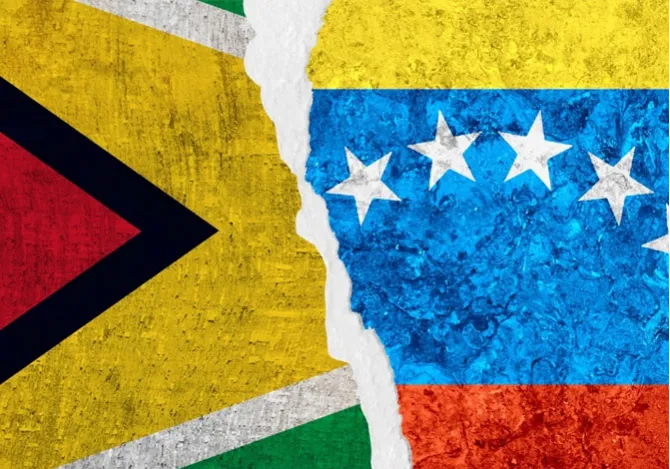
As tensions rise between Venezuela and Guyana, Brazil’s President Luiz Inacio ‘Lula’ da Silva stepped in to mediate the conflict, remarking at a recent conference, “If there is one thing we don’t want here in South America, it’s war.” Although some countries have grappled with domestic conflicts, Latin America has been free from major wars for the entire 20th and 21st centuries. The last multi-country war in the region was the War of the Pacific in 1879. Understandably, the recent Venezuela-Guyana border dispute is overshadowed by an uneasy sense of foreboding in a region that has not seen a major international conflict for 150 years.
Background
Venezuela and Guyana are perhaps the most diametrically opposed economies in the world today, and they happen to be neighbours. Guyana’s economy expanded by 62 percent in 2022, making it the “highest real GDP (Gross Domestic Product) growth in the world in 2022.” Right next door is Venezuela, where inflation has ballooned to 360 percent in 2023, also the highest in the world. Guyana’s economic boom has been in the news just as much as Venezuela’s economic demise. Yet, for all its hullabaloo, the recent border dispute is little more than a storm in a teacup.
The recent Venezuela-Guyana border dispute is overshadowed by an uneasy sense of foreboding in a region that has not seen a major international conflict for 150 years.
The current dispute is over the Essequibo region, a massive area of 61,600 square miles with a population of 125,000 people, the large majority of whom speak English. The region is administered by Guyana but is now being claimed by Venezuela. The Essequibo is notable for two reasons: it is massive, making up roughly two-thirds of the entire land area of Guyana, even larger than the size of England; and it is rich in natural resources, primarily petroleum.
This is not a new territorial dispute. It has its roots in the colonial era dating back to the late 1800s when the United States (US) and the United Kingdom (UK) agreed to split the territory between modern-day Guyana and Venezuela, granting a majority of the Essequibo region to the Guyanese administration. The dispute stayed mostly dormant in the 21st century and was revived after Guyana discovered abundant petroleum reserves in the territorial waters above the Essequibo region in 2013.
The current escalation is fueled by Venezuela’s Nicolas Maduro, who has so far attempted to use the issue to bolster support at home. Maduro even organised a referendum in Venezuela to lend more legitimacy to his cause, but the dismal voter turnout suggests that Venezuelans are more concerned about domestic issues like violent crime and spiraling inflation. To a limited extent, Maduro seems to have succeeded in diverting attention away from the domestic political Opposition and the upcoming elections.
The Essequibo is notable for two reasons: it is massive, making up roughly two-thirds of the entire land area of Guyana, even larger than the size of England; and it is rich in natural resources, primarily petroleum.
What next?
Several mediators, including Brazil’s Lula, United Nations Secretary-General, António Guterres, as well as regional bodies including the Community of Latin American and Caribbean States (CELAC) and the Caribbean Community (CARICOM), have helped in diffusing tensions between Venezuela and Guyana. Venezuela’s Maduro and Guyana’s President Irfaan Ali met in Argyle, Saint Vincent and the Grenadines on 14 December, agreeing to “not threaten or use force against one another in any circumstances, including those consequential to any existing controversies between the two states.” Both countries are expected to meet again after three months, even as their militaries stand on high alert. Despite the seemingly cordial diplomatic entente in Argyle, Venezuela has deployed 5,000 soldiers along with F-16 and Sukhoi fighter jets near Guyana’s border. In response, Guyana flaunted its rather powerful coterie on 29 December by receiving the HMS Trent, a warship from the United Kingdom. If push comes to shove, Venezuela’s military capabilities far outweigh Guyana’s—according to an article published by Bloomberg, the military imbalance favours Venezuela by 100 to 1. Yet, an actual invasion would be a cumbersome exercise, given that the Essequibo has barely any infrastructure and would also present a significant cultural and linguistic challenge in being incorporated as a part of Venezuela. To most observers, it makes little to no sense for Venezuela to invade Guyanese Essequibo; but it remains to be seen if Maduro will be willing to push the envelope to maintain power.
Venezuela’s Maduro and Guyana’s President Irfaan Ali met in Argyle, Saint Vincent and the Grenadines on 14 December, agreeing to “not threaten or use force against one another in any circumstances, including those consequential to any existing controversies between the two states.”
Whether the Venezuela-Guyana conflict eventually fizzles out or continues to fester, New Delhi should keep a close watch. After all, Venezuela accounted for as much as 12 percent of India’s total oil imports just some years ago. Although Guyana does not currently export oil to India, it is only a matter of time before market forces become more amenable to the Guyana-India oil trade. Besides, Guyana’s relationship with India runs deeper than commerce—the largest ethnic group in Guyana are Indians, known as Indo-Guyanese, and make up about 40 percent of the population. For now, New Delhi will not have to pick a side. Hopefully, better sense prevails and Latin America can continue to be free from international conflict in the 21st century.
Hari Seshasayee is a Visiting Fellow at ORF part of the Strategic Studies Programme
The views expressed above belong to the author(s). ORF research and analyses now available on Telegram! Click here to access our curated content — blogs, longforms and interviews.




 PREV
PREV


